Table of contents
- Main points
- Statistician’s quote
- Things you need to know
- Recent internet use is on the increase for those aged 65 and over
- A higher proportion of men than women aged 65 and over are recent internet users
- 25% of disabled adults had never used the internet
- Recent internet use increased for inactive and retired adults
- London was the highest NUTS 1 region for recent internet use
- Your views matter
- Main issues specific to this bulletin
- Quality and methodology
1. Main points
87.9% of adults in the UK (45.9 million) had recently (in the last 3 months) used the internet, compared with 86.2% in 2015.
10.2% (5.3 million) had never used the internet compared with 11.4% in 2015.
Almost all adults aged 16 to 24 years were recent internet users (99.2%), in contrast with 38.7% of adults aged 75 years and over.
89.4% of men (22.8 million) and 86.4% of women (23.1 million) were recent internet users, up from 87.9% and 84.6% in 2015.
Women aged 75 and over, had seen the largest rise in recent internet use, up 169.0% from 2011; however, still less than a third (32.6%) were recent users in 2016.
25.0% of disabled adults had never used the internet in 2016, down from 27.4% in 2015.
Of the NUTS 1 regions, Northern Ireland had seen the largest increase (13.2 percentage points) in recent internet use since 2011; however, in 2016 it was still the region with the lowest recent usage (82.0%).
Inactive adults who had never used the internet or who used the internet more than 3 months ago, has decreased by 13.3 percentage points since 2011.
2. Statistician’s quote
“While we have seen a notable increase in internet usage across all groups in recent years, many older and disabled people are still not online, with two-thirds of women over 75 having never used the internet.”
Pete Lee, Surveys and Economic Indicators Division, Office for National Statistics
Back to table of contents3. Things you need to know
In this release each year represents the period Quarter 1 (January to March). This release is the first to identify estimates on an annual basis; previous releases have included all quarters for each year. The estimates included in the release are from the survey period January to March in each year equivalent to estimates shown for Quarter 1 (Jan to Mar) in the 2015 release. This is to enable you to compare the data more easily.
The estimates used are derived from the Labour Force Survey (LFS) and are not seasonally adjusted.
The detailed regional estimates are based on smaller sample sizes than the higher level regional estimates and are therefore subject to a greater degree of sampling variability, so should be treated with caution. In addition, in the higher level regional estimates, the categories of "last used the internet more than 3 months ago" and "never used" have been combined due to the small number of responses at this level of geography.
Comparisons made between estimates in this release and the annual Internet access – households and individuals publication should be undertaken with caution. The Internet Access – Households and Individuals 2015 statistical bulletin provides more information on the range of activities carried out on the internet but the estimates are derived from the Opinions and Lifestyle Survey, which has a much smaller sample size than the LFS from which Internet users is derived.
Estimates of adults with a disability as defined by the Equality Act are presented from 2014. The term “disabled” is used to refer to those who self-assess that they have a disability in line with the Equality Act. These should not be compared directly with the estimates in 2011 to 2013 which are defined by the Disability Discrimination Act (DDA).
Back to table of contents4. Recent internet use is on the increase for those aged 65 and over
Age is a factor as to whether an adult has used the internet. Since the survey began in 2011, adults aged 75 years and over have consistently shown the lowest rates of internet use. In 2011, the percentage of recent internet users aged 75 and over was 19.9%. In 2016, this has nearly doubled to 38.7%, up from 33.0% in 2015.
Recent internet use in the 65 to 74 age group has increased by 68.7% since 2011. Since 2015, there has been an increase of 7.5% in the same age group.
In 2016, almost all adults aged 16 to 24 and 25 to 34 years were recent internet users (99.2% and 98.9% respectively).
Figure 1: Recent internet users by age group, UK, 2016
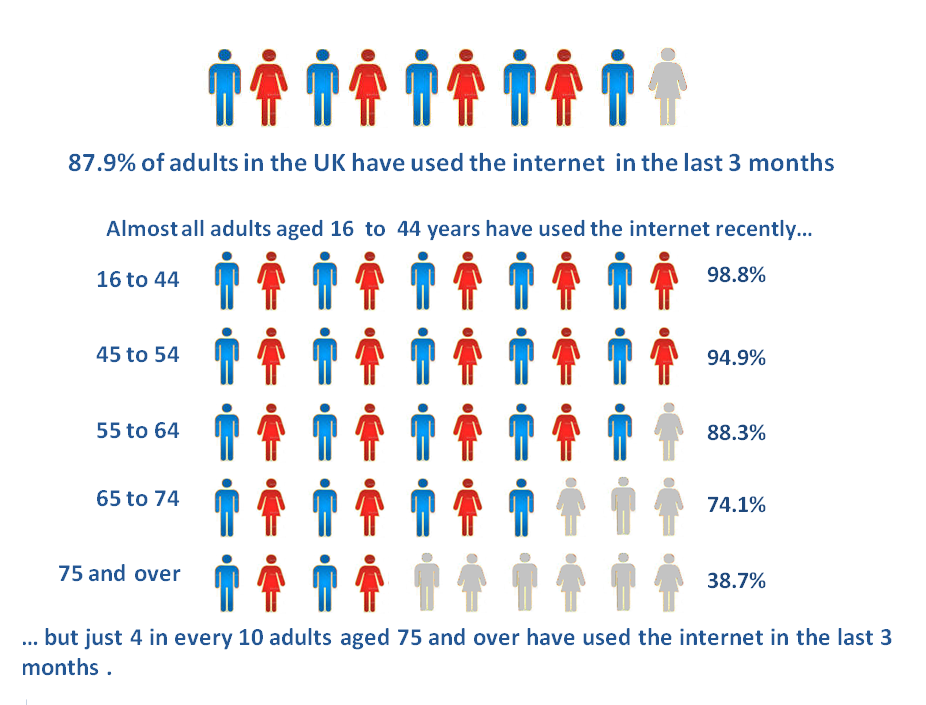
Source: Office for National Statistics
Download this image Figure 1: Recent internet users by age group, UK, 2016
.png (144.4 kB) .xls (18.9 kB)Adults aged 75 years and over had the highest rate of lapsed internet users in 2016 at 4.8%, compared with only 0.2% of adults aged 16 to 24 years. This suggests that, although more adults aged 75 years and over start using the internet, they are not necessarily continuing to use the internet.
Although recent internet use is notably lower in the older age groups, the proportion of adults aged 75 years and over who had never used the internet decreased from 76.1% in 2011 to 56.5% in 2016.
Of the 5.3 million adults who had never used the internet in 2016, just over half (2.8 million) were aged 75 years and over. This age group make up 9.5% of the population aged over 16 years.
Figure 2: Recent internet use in 2011 and 2016 by age group, UK
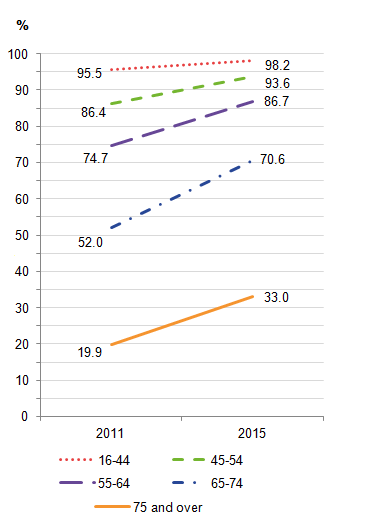
Source: Office for National Statistics
Download this image Figure 2: Recent internet use in 2011 and 2016 by age group, UK
.png (9.8 kB) .xls (18.4 kB)5. A higher proportion of men than women aged 65 and over are recent internet users
Since 2011, the largest increase in recent internet use has been in the older age groups, for both men and women. The largest increases in the number of recent internet users were in women aged 75 and over (169.0%), women aged 65 to 74 (80.7%) and men aged 75 and over (80.3%).
Since 2015, the largest increases in the number of recent internet users were women aged 75 and over (19.7%) and men aged 75 and over (16.4%).
Men in the oldest 2 age groups are more likely to use the internet than women in the same age groups. In 2016, 46.7% of men aged 75 years and over were recent internet users compared with 32.6% of women. In the 65 to 74 age group the gap between men and women using the internet in the last 3 months has closed, with 75.8% of men and 72.5% of women being recent internet users in 2016, compared with 73.0% and 68.4% in 2015, and 57.4% of men and 47.1% of women in 2011.
There is little difference in the rates of internet use between men and women in all age groups under 65 years of age.
Figure 3: Recent internet users in last 3 months by age group and sex, UK, 2016
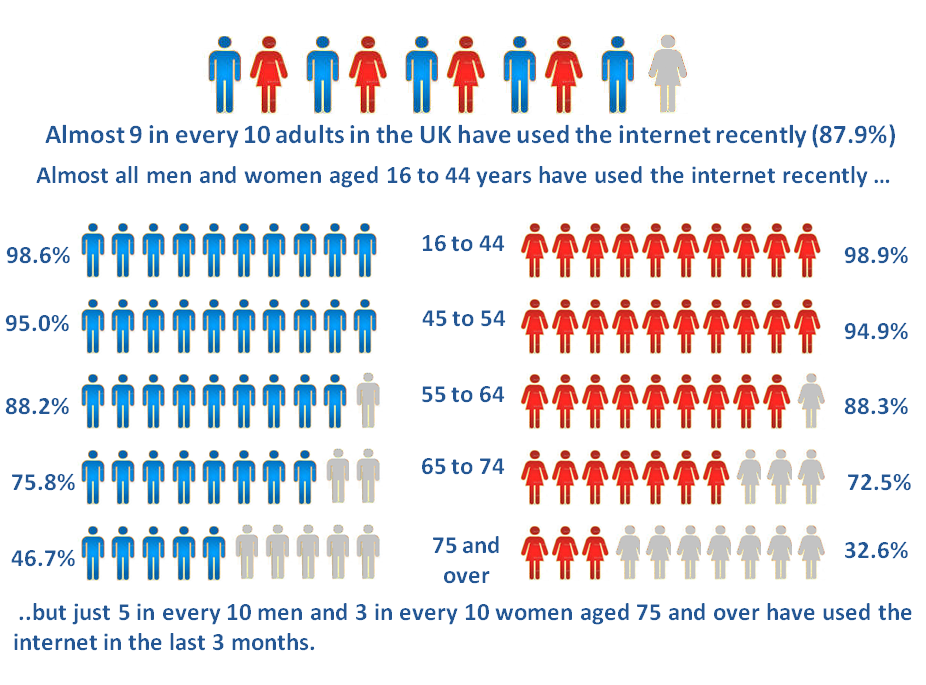
Source: Office for National Statistics
Download this image Figure 3: Recent internet users in last 3 months by age group and sex, UK, 2016
.png (153.3 kB) .xls (28.2 kB)
Figure 4: Recent internet use in 2011 and 2016 by age group and sex, UK
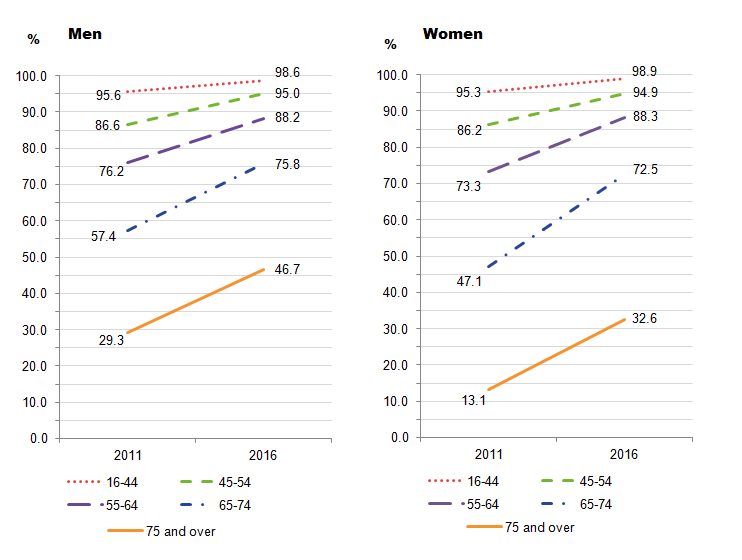
Source: Office for National Statistics
Download this image Figure 4: Recent internet use in 2011 and 2016 by age group and sex, UK
.png (18.9 kB) .xls (27.1 kB)In all age groups, women have seen a more substantial increase in recent internet use compared with men, rising by 9.6 percentage points and 7.3 percentage points respectively since 2011. There is still a higher proportion of women who had never used the internet (11.6%) compared with men (8.7%). The figures for lapsed users are very similar for both sexes.
Figure 5: Internet use and non-use by sex, 2011 to 2016, UK
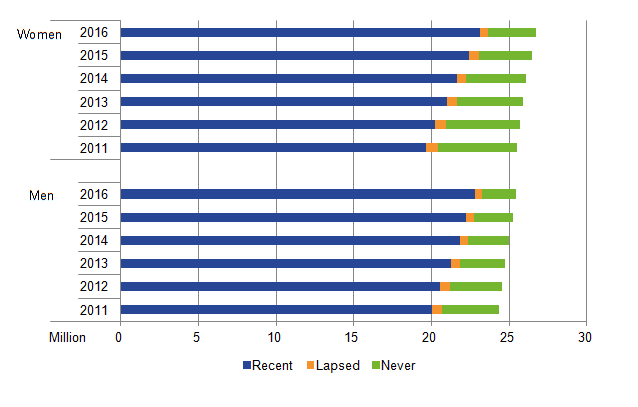
Source: Office for National Statistics
Download this image Figure 5: Internet use and non-use by sex, 2011 to 2016, UK
.png (9.6 kB) .xls (18.9 kB)6. 25% of disabled adults had never used the internet
There were 0.5 million disabled adults who had last used the internet over 3 months ago, making up 50.0% of the 0.9 million lapsed internet users.
In 2016, 97.3% of disabled adults aged 16 to 24 years were recent internet users, compared with 99.4% who were not disabled. Of disabled adults aged 75 years and over, 30.8% were recent internet users, compared with 48.1% who were not disabled. Across all age groups, the proportion of adults who were recent internet users was lower for those that were disabled, compared with those that were not.
Since 2015, the number of disabled adults who had used the internet in the last 3 months has increased by 6.8% to 8.6 million in 2016.
Figure 6: Internet use and non-use by disability status, 2014 to 2016, UK
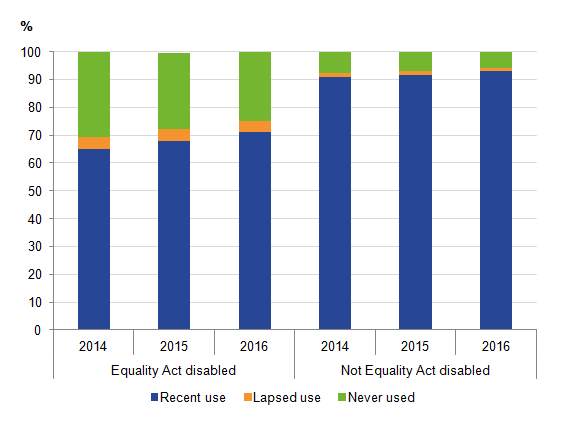
Source: Office for National Statistics
Download this image Figure 6: Internet use and non-use by disability status, 2014 to 2016, UK
.png (14.7 kB) .xls (27.6 kB)7. Recent internet use increased for inactive and retired adults
Recent internet use for adults aged 65 and over has increased since 2011 and we have provided new analysis on recent internet use by economic activity (Tables 7A and 7B in the internet users dataset).
Recent internet use in the retired category has increased by 19.1 percentage points since 2011, followed by the inactive category increasing by 13.5 percentage points.
Back to table of contents8. London was the highest NUTS 1 region for recent internet use
The NUTS Classification is a hierarchical system dividing up economic territory of the EU for the purpose of regional statistics. There are 3 NUTS levels, all of which are used in this release.
Of the NUTS 1 regions, London was the area with the highest proportion of recent users (91.0%) and Northern Ireland had the lowest proportion of recent internet users (82.0%). In 2015, the South East had the highest proportion of recent internet users (89.6%) and Northern Ireland was the area with the lowest proportion (79.6%).
The areas with the largest increase in recent internet use since 2011 are Northern Ireland, up 13.2 percentage points and the North West, up 10.6 percentage points.
Figure 7: Internet use, 2016 by NUTS3 area, UK
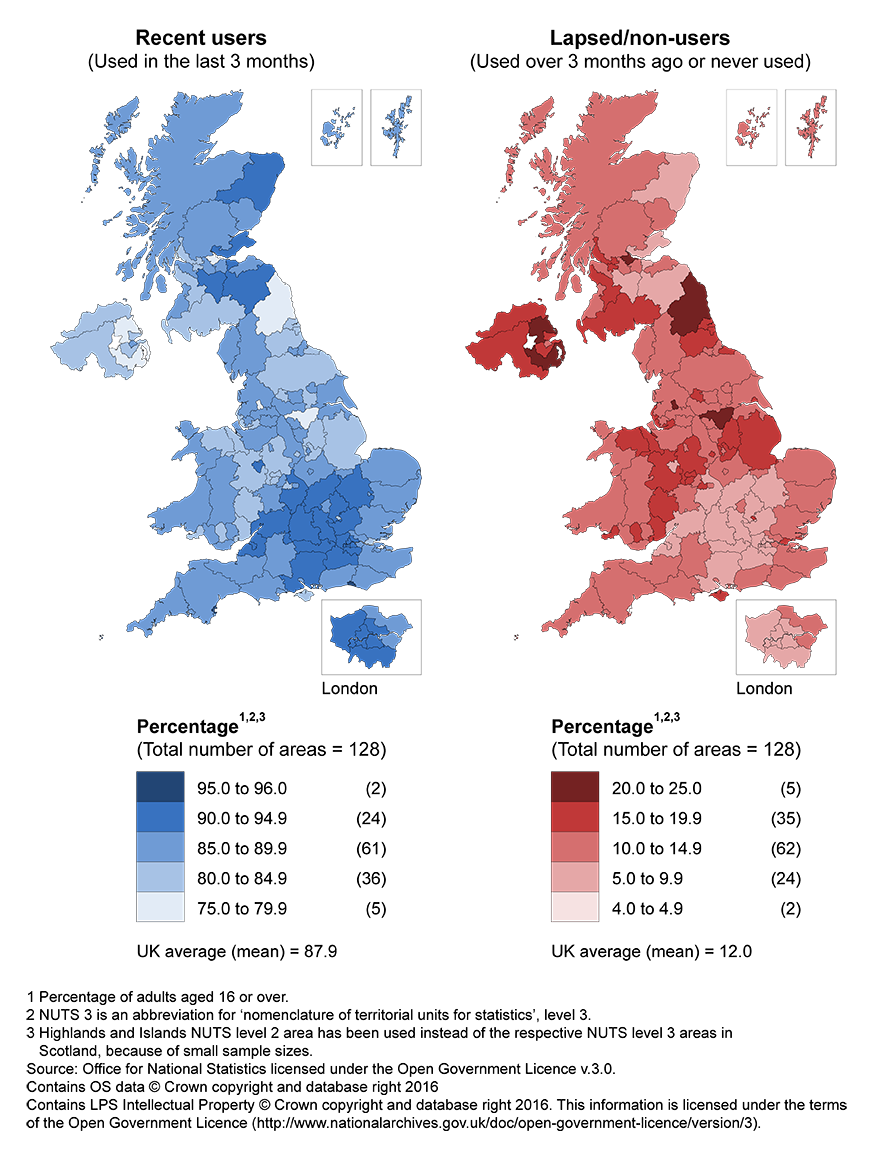
Source: Office for National Statistics
Download this image Figure 7: Internet use, 2016 by NUTS3 area, UK
.png (455.2 kB)The maps show the proportion of internet use by NUTS 3, the most detailed geographical classification available. While there is sampling variability around these estimates, in 2016 the area with the highest proportion of adults who had last used the internet more than 3 months ago, or who had never used it, was Falkirk (25.0%). The highest proportion of adults who had recently used the internet was in Brighton and Hove (96.0%).
Back to table of contents9. Your views matter
We are constantly aiming to improve this release and its associated commentary. We would welcome any feedback you might have; please contact us via email: esociety@ons.gov.uk or telephone Cecil Prescott on +44 (0)1633 456767.
Back to table of contents10. Main issues specific to this bulletin
New data tables 7A and 7B have been introduced in this release for your interest, detailing the internet use by economic activity.
There are no revisions to estimates previously published.
Back to table of contents11. Quality and methodology
The Internet Users Quality and Methodology Information document contains important information on:
- the strengths and limitations of the data
- the quality of the output: including the accuracy of the data, how it compares with related data
- uses and users
- how the output was created
Labour Force Survey Quality and Methodology Information contains information on the sample used for this release
Back to table of contents
